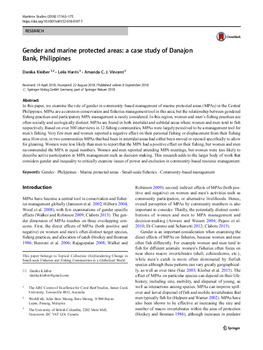Gender and marine protected areas: a case study of Danajon Bank, Philippines
Abstract
In this paper, we examine the role of gender in community-based management of marine protected areas (MPAs) in the Central Philippines. MPAs are a common conservation and fisheries management tool in this area, but the relationship between gendered fishing practices and participatory MPA management is rarely considered. In this region, women and men’s fishing practices are often socially and ecologically distinct. MPAs are found in both intertidal and subtidal areas where women and men tend to fish respectively. Based on over 500 interviews in 12 fishing communities, MPAs were largely perceived to be a management tool for men’s fishing. Very few men and women reported a negative effect on their personal fishing or displacement from their fishing area. However, in two communities MPAs that had been in intertidal areas had either been moved or opened specifically to allow for gleaning. Women were less likely than men to report that the MPA had a positive effect on their fishing, but women and men recommended the MPA in equal numbers. Women and men reported attending MPA meetings, but women were less likely to describe active participation in MPA management such as decision making. This research adds to the larger body of work that considers gender and inequality to critically examine issues of power and exclusion in community-based resource management

